BIOMETRIC DATA IN LEARNING ANALYTICS: A SURVEY ON EXISTING APPLICATIONS
BIOMETRIC DATA IN LEARNING ANALYTICS: A SURVEY ON EXISTING APPLICATIONS
Author(s): Viviana Elena Dinu, Dalia Papuc, Alexandru Gheorghiu, Maria-Iuliana Dascălu, Alin Moldoveanu, Florica MoldoveanuSubject(s): Social Sciences
Published by: Carol I National Defence University Publishing House
Keywords: Learning Analytics; biometric sensors; brain computer interface; decision making process.
Summary/Abstract: Learning analytics (LA) is among the most emergent research fields nowadays, as a consequence of the technological progress (e.g. big data, cloud technologies, virtual reality, brain computer interface) and of the importance given to education and new forms of education (computer-based, online). Also, the European Digital Agenda proposes an efficient equitable digital education, with a positive impact on economy. This goal can be achieved only through a continuum measurement and improvement of educational activities, aspect highly taken into account by LA. Society for Learning Analytics Research (SoLAR) defines LA as the measurement, collection, analysis and report of data about students and about their learning contexts, with the purpose of understanding and optimizing the learning process and also the environment in which the learning takes place. Also, the cultural values of today’s society changed: the education takes place in different places, not only in a formal institution. Thus, huge amounts of heterogeneous data related to a particular student can be gathered from different sources and, in order to provide an accurate diagnostic of the educational profile of that student, LA has to be based on all the data, despite of its provenience. This paper discusses about LA: provides a detailed definition of what LA is, in connection with the fields to which it can be applied, revises the benefits brought by LA to education and underlines the multitude of LA data sources. The focus is then put on biometric data, as a consequence of the recent technologies and devices allowing the collection and analysis of this data, e.g. magnetometers for Magnetoencephalography, scanning technology for Functional Magnetic Resonance Imaging, electrodes placed directly on the brain or recording caps, web tools that analyse the online activity of a user. Finally, a set of applications exploiting biometric data with the purpose of analysing and improving the learning process are described and compared.
Journal: Conference proceedings of »eLearning and Software for Education« (eLSE)
- Issue Year: 13/2017
- Issue No: 02
- Page Range: 465-472
- Page Count: 8
- Language: English

